Cómo detectar un Árbol de Navidad?
¿Qué técnicas de procesamiento de imágenes se podrían utilizar para implementar una aplicación que detecta los árboles de Navidad que se muestran en las siguientes imágenes?
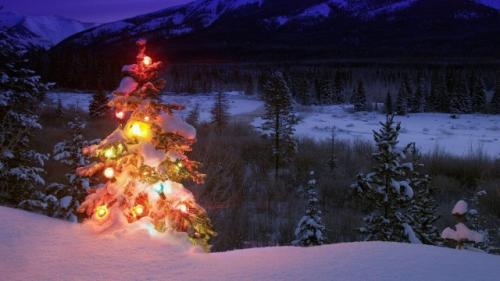

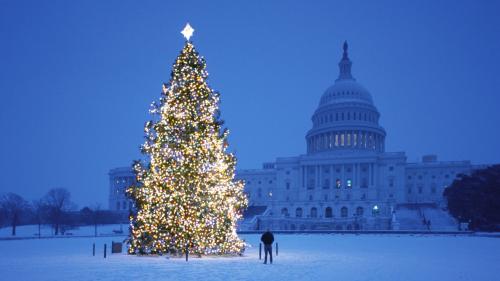
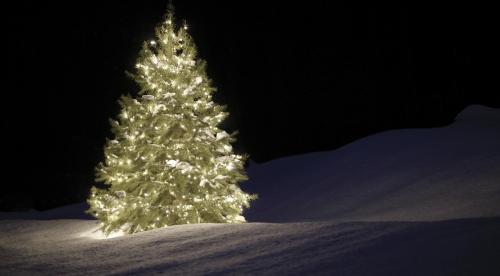
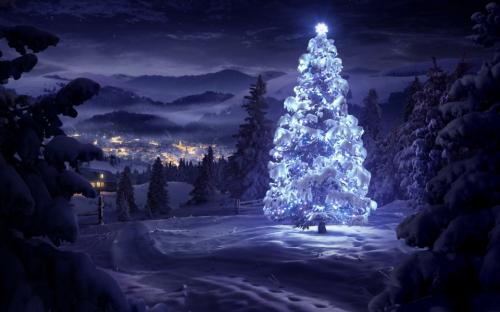
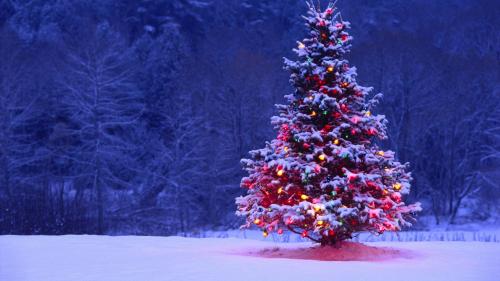
Estoy buscando soluciones que van a funcionar en todas estas imágenes. Por lo tanto, los enfoques que requieren capacitación clasificadores en cascada de haar o coincidencia de plantillas no son muy interesantes.
Estoy buscando algo que pueda ser escrito en cualquier lenguaje de programación, mientras se utiliza sólo código Abierto tecnologías. La solución debe probarse con las imágenes que se comparten en esta pregunta. Hay 6 imágenes de entrada y la respuesta debe mostrar los resultados del procesamiento de cada una de ellas. Finalmente, para cada imagen de salida debe haber líneas rojas dibujar para rodear el árbol detectado.
¿ Cómo irías sobre la detección programática de los árboles en estos ¿imágenes?
10 answers
Tengo un enfoque que creo que es interesante y un poco diferente del resto. La principal diferencia en mi enfoque, en comparación con algunos de los otros, está en cómo se realiza el paso de segmentación de imágenes used Usé el algoritmo de clustering DBSCAN del scikit-learn de Python; está optimizado para encontrar formas algo amorfas que no necesariamente tienen un solo centroide claro.
En el nivel superior, mi enfoque es bastante simple y se puede dividir en aproximadamente 3 pasos. Primero aplico un umbral (o en realidad, el "o" lógico de dos umbrales separados y distintos). Al igual que con muchas de las otras respuestas, asumí que el árbol de Navidad sería uno de los objetos más brillantes de la escena, por lo que el primer umbral es solo una simple prueba de brillo monocromático; cualquier píxel con valores superiores a 220 en una escala de 0-255 (donde el negro es 0 y el blanco es 255) se guardan en una imagen binaria en blanco y negro. El segundo umbral intenta buscar luces rojas y amarillas, que son particularmente prominente en los árboles en la parte superior izquierda e inferior derecha de las seis imágenes, y se destacan bien contra el fondo azul-verde que prevalece en la mayoría de las fotos. Convierto la imagen rgb a espacio hsv, y requiero que el tono sea menor que 0.2 en una escala de 0.0-1.0 (correspondiente aproximadamente al borde entre amarillo y verde) o mayor que 0.95 (correspondiente al borde entre púrpura y rojo) y, además, requiero colores brillantes y saturados: saturación y el valor debe estar por encima de 0.7. Los resultados de los dos procedimientos de umbral son lógicamente"or" -ed juntos, y la matriz resultante de imágenes binarias en blanco y negro se muestra a continuación:
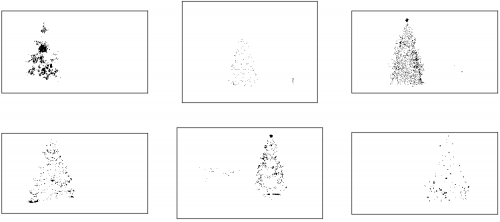
Se puede ver claramente que cada imagen tiene un gran grupo de píxeles aproximadamente correspondiente a la ubicación de cada árbol, además de algunas de las imágenes también tienen algunos otros pequeños grupos que corresponden a las luces en las ventanas de algunos de los edificios, o a una escena de fondo en el horizonte. El siguiente paso es hacer que el equipo reconozca que se trata de clústeres separados y etiquetar cada píxel correctamente con un número de identificación de pertenencia al clúster.
Para esta tarea elegí DBSCAN. Hay una comparación visual bastante buena de cómo se comporta típicamente DBSCAN, en relación con otros algoritmos de clustering, disponibles aquí . Como dije antes, funciona bien con formas amorfas. Se muestra la salida de DBSCAN, con cada clúster trazado en un color diferente aquí:

Hay algunas cosas a tener en cuenta cuando se mira este resultado. En primer lugar, DBSCAN requiere que el usuario establezca un parámetro de "proximidad" para regular su comportamiento, lo que efectivamente controla cuán separados deben estar un par de puntos para que el algoritmo declare un nuevo clúster separado en lugar de aglomerar un punto de prueba en un clúster ya preexistente. Establecí este valor para ser 0.04 veces el tamaño a lo largo de la diagonal de cada imagen. Ya las imágenes varían en tamaño desde aproximadamente VGA hasta aproximadamente HD 1080, este tipo de definición relativa a la escala es fundamental.
Otro punto que vale la pena señalar es que el algoritmo DBSCAN tal y como está implementado en scikit-learn tiene límites de memoria que son bastante desafiantes para algunas de las imágenes más grandes de esta muestra. Por lo tanto, para algunas de las imágenes más grandes, en realidad tuve que "diezmar" (es decir, retener solo cada 3er o 4to píxel y eliminar los demás) cada clúster para permanecer dentro de este límite. Como resultado de este proceso de selección, los píxeles dispersos restantes son difíciles de ver en algunas de las imágenes más grandes. Por lo tanto, solo para fines de visualización, los píxeles codificados por colores en las imágenes anteriores se han "dilatado" efectivamente solo ligeramente para que se destaquen mejor. Es una operación puramente cosmética por el bien de la narrativa; aunque hay comentarios que mencionan esta dilatación en mi código, tenga la seguridad de que no tiene nada que ver con ningún cálculo que en realidad asunto.
Una vez que los clústeres se identifican y etiquetan, el tercer y último paso es fácil: simplemente tomo el clúster más grande en cada imagen (en este caso, elegí medir "tamaño" en términos del número total de píxeles de miembros, aunque uno podría haber utilizado con la misma facilidad algún tipo de métrica que mide la extensión física) y calcular el casco convexo para ese clúster. El casco convexo se convierte entonces en el borde del árbol. Los seis cascos convexos calculados a través de este método se muestran a continuación en rojo:
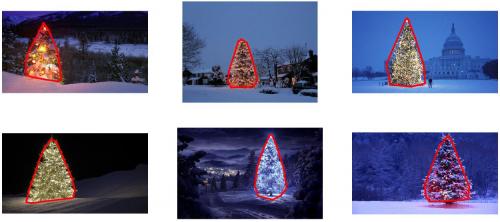
El código fuente es escrito para Python 2.7.6 y depende numpy, scipy, matplotlib y scikit-learn. Lo he dividido en dos partes. La primera parte es responsable del procesamiento real de la imagen:
from PIL import Image
import numpy as np
import scipy as sp
import matplotlib.colors as colors
from sklearn.cluster import DBSCAN
from math import ceil, sqrt
"""
Inputs:
rgbimg: [M,N,3] numpy array containing (uint, 0-255) color image
hueleftthr: Scalar constant to select maximum allowed hue in the
yellow-green region
huerightthr: Scalar constant to select minimum allowed hue in the
blue-purple region
satthr: Scalar constant to select minimum allowed saturation
valthr: Scalar constant to select minimum allowed value
monothr: Scalar constant to select minimum allowed monochrome
brightness
maxpoints: Scalar constant maximum number of pixels to forward to
the DBSCAN clustering algorithm
proxthresh: Proximity threshold to use for DBSCAN, as a fraction of
the diagonal size of the image
Outputs:
borderseg: [K,2,2] Nested list containing K pairs of x- and y- pixel
values for drawing the tree border
X: [P,2] List of pixels that passed the threshold step
labels: [Q,2] List of cluster labels for points in Xslice (see
below)
Xslice: [Q,2] Reduced list of pixels to be passed to DBSCAN
"""
def findtree(rgbimg, hueleftthr=0.2, huerightthr=0.95, satthr=0.7,
valthr=0.7, monothr=220, maxpoints=5000, proxthresh=0.04):
# Convert rgb image to monochrome for
gryimg = np.asarray(Image.fromarray(rgbimg).convert('L'))
# Convert rgb image (uint, 0-255) to hsv (float, 0.0-1.0)
hsvimg = colors.rgb_to_hsv(rgbimg.astype(float)/255)
# Initialize binary thresholded image
binimg = np.zeros((rgbimg.shape[0], rgbimg.shape[1]))
# Find pixels with hue<0.2 or hue>0.95 (red or yellow) and saturation/value
# both greater than 0.7 (saturated and bright)--tends to coincide with
# ornamental lights on trees in some of the images
boolidx = np.logical_and(
np.logical_and(
np.logical_or((hsvimg[:,:,0] < hueleftthr),
(hsvimg[:,:,0] > huerightthr)),
(hsvimg[:,:,1] > satthr)),
(hsvimg[:,:,2] > valthr))
# Find pixels that meet hsv criterion
binimg[np.where(boolidx)] = 255
# Add pixels that meet grayscale brightness criterion
binimg[np.where(gryimg > monothr)] = 255
# Prepare thresholded points for DBSCAN clustering algorithm
X = np.transpose(np.where(binimg == 255))
Xslice = X
nsample = len(Xslice)
if nsample > maxpoints:
# Make sure number of points does not exceed DBSCAN maximum capacity
Xslice = X[range(0,nsample,int(ceil(float(nsample)/maxpoints)))]
# Translate DBSCAN proximity threshold to units of pixels and run DBSCAN
pixproxthr = proxthresh * sqrt(binimg.shape[0]**2 + binimg.shape[1]**2)
db = DBSCAN(eps=pixproxthr, min_samples=10).fit(Xslice)
labels = db.labels_.astype(int)
# Find the largest cluster (i.e., with most points) and obtain convex hull
unique_labels = set(labels)
maxclustpt = 0
for k in unique_labels:
class_members = [index[0] for index in np.argwhere(labels == k)]
if len(class_members) > maxclustpt:
points = Xslice[class_members]
hull = sp.spatial.ConvexHull(points)
maxclustpt = len(class_members)
borderseg = [[points[simplex,0], points[simplex,1]] for simplex
in hull.simplices]
return borderseg, X, labels, Xslice
Y la segunda parte es un script a nivel de usuario que llama al primer archivo y genera todas las gráficas anteriores:
#!/usr/bin/env python
from PIL import Image
import numpy as np
import matplotlib.pyplot as plt
import matplotlib.cm as cm
from findtree import findtree
# Image files to process
fname = ['nmzwj.png', 'aVZhC.png', '2K9EF.png',
'YowlH.png', '2y4o5.png', 'FWhSP.png']
# Initialize figures
fgsz = (16,7)
figthresh = plt.figure(figsize=fgsz, facecolor='w')
figclust = plt.figure(figsize=fgsz, facecolor='w')
figcltwo = plt.figure(figsize=fgsz, facecolor='w')
figborder = plt.figure(figsize=fgsz, facecolor='w')
figthresh.canvas.set_window_title('Thresholded HSV and Monochrome Brightness')
figclust.canvas.set_window_title('DBSCAN Clusters (Raw Pixel Output)')
figcltwo.canvas.set_window_title('DBSCAN Clusters (Slightly Dilated for Display)')
figborder.canvas.set_window_title('Trees with Borders')
for ii, name in zip(range(len(fname)), fname):
# Open the file and convert to rgb image
rgbimg = np.asarray(Image.open(name))
# Get the tree borders as well as a bunch of other intermediate values
# that will be used to illustrate how the algorithm works
borderseg, X, labels, Xslice = findtree(rgbimg)
# Display thresholded images
axthresh = figthresh.add_subplot(2,3,ii+1)
axthresh.set_xticks([])
axthresh.set_yticks([])
binimg = np.zeros((rgbimg.shape[0], rgbimg.shape[1]))
for v, h in X:
binimg[v,h] = 255
axthresh.imshow(binimg, interpolation='nearest', cmap='Greys')
# Display color-coded clusters
axclust = figclust.add_subplot(2,3,ii+1) # Raw version
axclust.set_xticks([])
axclust.set_yticks([])
axcltwo = figcltwo.add_subplot(2,3,ii+1) # Dilated slightly for display only
axcltwo.set_xticks([])
axcltwo.set_yticks([])
axcltwo.imshow(binimg, interpolation='nearest', cmap='Greys')
clustimg = np.ones(rgbimg.shape)
unique_labels = set(labels)
# Generate a unique color for each cluster
plcol = cm.rainbow_r(np.linspace(0, 1, len(unique_labels)))
for lbl, pix in zip(labels, Xslice):
for col, unqlbl in zip(plcol, unique_labels):
if lbl == unqlbl:
# Cluster label of -1 indicates no cluster membership;
# override default color with black
if lbl == -1:
col = [0.0, 0.0, 0.0, 1.0]
# Raw version
for ij in range(3):
clustimg[pix[0],pix[1],ij] = col[ij]
# Dilated just for display
axcltwo.plot(pix[1], pix[0], 'o', markerfacecolor=col,
markersize=1, markeredgecolor=col)
axclust.imshow(clustimg)
axcltwo.set_xlim(0, binimg.shape[1]-1)
axcltwo.set_ylim(binimg.shape[0], -1)
# Plot original images with read borders around the trees
axborder = figborder.add_subplot(2,3,ii+1)
axborder.set_axis_off()
axborder.imshow(rgbimg, interpolation='nearest')
for vseg, hseg in borderseg:
axborder.plot(hseg, vseg, 'r-', lw=3)
axborder.set_xlim(0, binimg.shape[1]-1)
axborder.set_ylim(binimg.shape[0], -1)
plt.show()
Warning: date(): Invalid date.timezone value 'Europe/Kyiv', we selected the timezone 'UTC' for now. in /var/www/agent_stack/data/www/ajaxhispano.com/template/agent.layouts/content.php on line 61
2013-12-31 05:12:23
EDITAR NOTA: Edité este post para (i) procesar cada imagen de árbol individualmente, como se solicita en los requisitos, (ii) considerar tanto el brillo como la forma del objeto para mejorar la calidad del resultado.
A continuación se presenta un enfoque que toma en consideración el brillo y la forma del objeto. En otras palabras, busca objetos con forma de triángulo y con un brillo significativo. Se implementó en Java, usando Marvin procesamiento de imágenes marco.
El primer paso es el umbral de color. El objetivo aquí es enfocar el análisis en objetos con un brillo significativo.
Salida imágenes:
Http://marvinproject.sourceforge.net/other/trees/tree_1threshold.png http://marvinproject.sourceforge.net/other/trees/tree_2threshold.png http://marvinproject.sourceforge.net/other/trees/tree_3threshold.png
Http://marvinproject.sourceforge.net/other/trees/tree_4threshold.png http://marvinproject.sourceforge.net/other/trees/tree_5threshold.png http://marvinproject.sourceforge.net/other/trees/tree_6threshold.png
Fuente código:
public class ChristmasTree {
private MarvinImagePlugin fill = MarvinPluginLoader.loadImagePlugin("org.marvinproject.image.fill.boundaryFill");
private MarvinImagePlugin threshold = MarvinPluginLoader.loadImagePlugin("org.marvinproject.image.color.thresholding");
private MarvinImagePlugin invert = MarvinPluginLoader.loadImagePlugin("org.marvinproject.image.color.invert");
private MarvinImagePlugin dilation = MarvinPluginLoader.loadImagePlugin("org.marvinproject.image.morphological.dilation");
public ChristmasTree(){
MarvinImage tree;
// Iterate each image
for(int i=1; i<=6; i++){
tree = MarvinImageIO.loadImage("./res/trees/tree"+i+".png");
// 1. Threshold
threshold.setAttribute("threshold", 200);
threshold.process(tree.clone(), tree);
}
}
public static void main(String[] args) {
new ChristmasTree();
}
}
En el segundo paso, los puntos más brillantes de la imagen se dilatan para formar formas. El resultado de este proceso es la forma probable de los objetos con un brillo significativo. Al aplicar la segmentación de relleno de inundación, se detectan formas desconectadas.
Salida imágenes:
Http://marvinproject.sourceforge.net/other/trees/tree_1_fill.png http://marvinproject.sourceforge.net/other/trees/tree_2_fill.png http://marvinproject.sourceforge.net/other/trees/tree_3_fill.png
Http://marvinproject.sourceforge.net/other/trees/tree_4_fill.png http://marvinproject.sourceforge.net/other/trees/tree_5_fill.png http://marvinproject.sourceforge.net/other/trees/tree_6_fill.png
Fuente código:
public class ChristmasTree {
private MarvinImagePlugin fill = MarvinPluginLoader.loadImagePlugin("org.marvinproject.image.fill.boundaryFill");
private MarvinImagePlugin threshold = MarvinPluginLoader.loadImagePlugin("org.marvinproject.image.color.thresholding");
private MarvinImagePlugin invert = MarvinPluginLoader.loadImagePlugin("org.marvinproject.image.color.invert");
private MarvinImagePlugin dilation = MarvinPluginLoader.loadImagePlugin("org.marvinproject.image.morphological.dilation");
public ChristmasTree(){
MarvinImage tree;
// Iterate each image
for(int i=1; i<=6; i++){
tree = MarvinImageIO.loadImage("./res/trees/tree"+i+".png");
// 1. Threshold
threshold.setAttribute("threshold", 200);
threshold.process(tree.clone(), tree);
// 2. Dilate
invert.process(tree.clone(), tree);
tree = MarvinColorModelConverter.rgbToBinary(tree, 127);
MarvinImageIO.saveImage(tree, "./res/trees/new/tree_"+i+"threshold.png");
dilation.setAttribute("matrix", MarvinMath.getTrueMatrix(50, 50));
dilation.process(tree.clone(), tree);
MarvinImageIO.saveImage(tree, "./res/trees/new/tree_"+1+"_dilation.png");
tree = MarvinColorModelConverter.binaryToRgb(tree);
// 3. Segment shapes
MarvinImage trees2 = tree.clone();
fill(tree, trees2);
MarvinImageIO.saveImage(trees2, "./res/trees/new/tree_"+i+"_fill.png");
}
private void fill(MarvinImage imageIn, MarvinImage imageOut){
boolean found;
int color= 0xFFFF0000;
while(true){
found=false;
Outerloop:
for(int y=0; y<imageIn.getHeight(); y++){
for(int x=0; x<imageIn.getWidth(); x++){
if(imageOut.getIntComponent0(x, y) == 0){
fill.setAttribute("x", x);
fill.setAttribute("y", y);
fill.setAttribute("color", color);
fill.setAttribute("threshold", 120);
fill.process(imageIn, imageOut);
color = newColor(color);
found = true;
break Outerloop;
}
}
}
if(!found){
break;
}
}
}
private int newColor(int color){
int red = (color & 0x00FF0000) >> 16;
int green = (color & 0x0000FF00) >> 8;
int blue = (color & 0x000000FF);
if(red <= green && red <= blue){
red+=5;
}
else if(green <= red && green <= blue){
green+=5;
}
else{
blue+=5;
}
return 0xFF000000 + (red << 16) + (green << 8) + blue;
}
public static void main(String[] args) {
new ChristmasTree();
}
}
Como se muestra en la imagen de salida, se detectaron varias formas. En este problema, hay unos pocos puntos brillantes en las imágenes. Sin embargo, este enfoque se aplicó para hacer frente a escenarios más complejos.
En el siguiente paso se analiza cada forma. Un algoritmo simple detecta formas con un patrón similar a un triángulo. El algoritmo analiza la forma del objeto línea por línea. Si el centro de la masa de cada línea de forma es casi el mismo (dado un umbral) y aumento de masa a medida que aumenta y, el objeto tiene una forma de triángulo. La masa de la línea de forma es el número de píxeles en esa línea que pertenece a la forma. Imagine que corta el objeto horizontalmente y analiza cada segmento horizontal. Si están centralizados entre sí y la longitud aumenta desde el primer segmento hasta el último en un patrón lineal, probablemente tenga un objeto que se asemeje a un triángulo.
Código Fuente:
private int[] detectTrees(MarvinImage image){
HashSet<Integer> analysed = new HashSet<Integer>();
boolean found;
while(true){
found = false;
for(int y=0; y<image.getHeight(); y++){
for(int x=0; x<image.getWidth(); x++){
int color = image.getIntColor(x, y);
if(!analysed.contains(color)){
if(isTree(image, color)){
return getObjectRect(image, color);
}
analysed.add(color);
found=true;
}
}
}
if(!found){
break;
}
}
return null;
}
private boolean isTree(MarvinImage image, int color){
int mass[][] = new int[image.getHeight()][2];
int yStart=-1;
int xStart=-1;
for(int y=0; y<image.getHeight(); y++){
int mc = 0;
int xs=-1;
int xe=-1;
for(int x=0; x<image.getWidth(); x++){
if(image.getIntColor(x, y) == color){
mc++;
if(yStart == -1){
yStart=y;
xStart=x;
}
if(xs == -1){
xs = x;
}
if(x > xe){
xe = x;
}
}
}
mass[y][0] = xs;
mass[y][3] = xe;
mass[y][4] = mc;
}
int validLines=0;
for(int y=0; y<image.getHeight(); y++){
if
(
mass[y][5] > 0 &&
Math.abs(((mass[y][0]+mass[y][6])/2)-xStart) <= 50 &&
mass[y][7] >= (mass[yStart][8] + (y-yStart)*0.3) &&
mass[y][9] <= (mass[yStart][10] + (y-yStart)*1.5)
)
{
validLines++;
}
}
if(validLines > 100){
return true;
}
return false;
}
Finalmente, la posición de cada forma similar a un triángulo y con un brillo significativo, en este caso un árbol de Navidad, se resalta en la imagen original, como se muestra a continuación.
Producto final imágenes:
Http://marvinproject.sourceforge.net/other/trees/tree_1_out_2.jpg http://marvinproject.sourceforge.net/other/trees/tree_2_out_2.jpg http://marvinproject.sourceforge.net/other/trees/tree_3_out_2.jpg
Http://marvinproject.sourceforge.net/other/trees/tree_4_out_2.jpg http://marvinproject.sourceforge.net/other/trees/tree_5_out_2.jpg http://marvinproject.sourceforge.net/other/trees/tree_6_out_2.jpg
Final código fuente:
public class ChristmasTree {
private MarvinImagePlugin fill = MarvinPluginLoader.loadImagePlugin("org.marvinproject.image.fill.boundaryFill");
private MarvinImagePlugin threshold = MarvinPluginLoader.loadImagePlugin("org.marvinproject.image.color.thresholding");
private MarvinImagePlugin invert = MarvinPluginLoader.loadImagePlugin("org.marvinproject.image.color.invert");
private MarvinImagePlugin dilation = MarvinPluginLoader.loadImagePlugin("org.marvinproject.image.morphological.dilation");
public ChristmasTree(){
MarvinImage tree;
// Iterate each image
for(int i=1; i<=6; i++){
tree = MarvinImageIO.loadImage("./res/trees/tree"+i+".png");
// 1. Threshold
threshold.setAttribute("threshold", 200);
threshold.process(tree.clone(), tree);
// 2. Dilate
invert.process(tree.clone(), tree);
tree = MarvinColorModelConverter.rgbToBinary(tree, 127);
MarvinImageIO.saveImage(tree, "./res/trees/new/tree_"+i+"threshold.png");
dilation.setAttribute("matrix", MarvinMath.getTrueMatrix(50, 50));
dilation.process(tree.clone(), tree);
MarvinImageIO.saveImage(tree, "./res/trees/new/tree_"+1+"_dilation.png");
tree = MarvinColorModelConverter.binaryToRgb(tree);
// 3. Segment shapes
MarvinImage trees2 = tree.clone();
fill(tree, trees2);
MarvinImageIO.saveImage(trees2, "./res/trees/new/tree_"+i+"_fill.png");
// 4. Detect tree-like shapes
int[] rect = detectTrees(trees2);
// 5. Draw the result
MarvinImage original = MarvinImageIO.loadImage("./res/trees/tree"+i+".png");
drawBoundary(trees2, original, rect);
MarvinImageIO.saveImage(original, "./res/trees/new/tree_"+i+"_out_2.jpg");
}
}
private void drawBoundary(MarvinImage shape, MarvinImage original, int[] rect){
int yLines[] = new int[6];
yLines[0] = rect[1];
yLines[1] = rect[1]+(int)((rect[3]/5));
yLines[2] = rect[1]+((rect[3]/5)*2);
yLines[3] = rect[1]+((rect[3]/5)*3);
yLines[4] = rect[1]+(int)((rect[3]/5)*4);
yLines[5] = rect[1]+rect[3];
List<Point> points = new ArrayList<Point>();
for(int i=0; i<yLines.length; i++){
boolean in=false;
Point startPoint=null;
Point endPoint=null;
for(int x=rect[0]; x<rect[0]+rect[2]; x++){
if(shape.getIntColor(x, yLines[i]) != 0xFFFFFFFF){
if(!in){
if(startPoint == null){
startPoint = new Point(x, yLines[i]);
}
}
in = true;
}
else{
if(in){
endPoint = new Point(x, yLines[i]);
}
in = false;
}
}
if(endPoint == null){
endPoint = new Point((rect[0]+rect[2])-1, yLines[i]);
}
points.add(startPoint);
points.add(endPoint);
}
drawLine(points.get(0).x, points.get(0).y, points.get(1).x, points.get(1).y, 15, original);
drawLine(points.get(1).x, points.get(1).y, points.get(3).x, points.get(3).y, 15, original);
drawLine(points.get(3).x, points.get(3).y, points.get(5).x, points.get(5).y, 15, original);
drawLine(points.get(5).x, points.get(5).y, points.get(7).x, points.get(7).y, 15, original);
drawLine(points.get(7).x, points.get(7).y, points.get(9).x, points.get(9).y, 15, original);
drawLine(points.get(9).x, points.get(9).y, points.get(11).x, points.get(11).y, 15, original);
drawLine(points.get(11).x, points.get(11).y, points.get(10).x, points.get(10).y, 15, original);
drawLine(points.get(10).x, points.get(10).y, points.get(8).x, points.get(8).y, 15, original);
drawLine(points.get(8).x, points.get(8).y, points.get(6).x, points.get(6).y, 15, original);
drawLine(points.get(6).x, points.get(6).y, points.get(4).x, points.get(4).y, 15, original);
drawLine(points.get(4).x, points.get(4).y, points.get(2).x, points.get(2).y, 15, original);
drawLine(points.get(2).x, points.get(2).y, points.get(0).x, points.get(0).y, 15, original);
}
private void drawLine(int x1, int y1, int x2, int y2, int length, MarvinImage image){
int lx1, lx2, ly1, ly2;
for(int i=0; i<length; i++){
lx1 = (x1+i >= image.getWidth() ? (image.getWidth()-1)-i: x1);
lx2 = (x2+i >= image.getWidth() ? (image.getWidth()-1)-i: x2);
ly1 = (y1+i >= image.getHeight() ? (image.getHeight()-1)-i: y1);
ly2 = (y2+i >= image.getHeight() ? (image.getHeight()-1)-i: y2);
image.drawLine(lx1+i, ly1, lx2+i, ly2, Color.red);
image.drawLine(lx1, ly1+i, lx2, ly2+i, Color.red);
}
}
private void fillRect(MarvinImage image, int[] rect, int length){
for(int i=0; i<length; i++){
image.drawRect(rect[0]+i, rect[1]+i, rect[2]-(i*2), rect[3]-(i*2), Color.red);
}
}
private void fill(MarvinImage imageIn, MarvinImage imageOut){
boolean found;
int color= 0xFFFF0000;
while(true){
found=false;
Outerloop:
for(int y=0; y<imageIn.getHeight(); y++){
for(int x=0; x<imageIn.getWidth(); x++){
if(imageOut.getIntComponent0(x, y) == 0){
fill.setAttribute("x", x);
fill.setAttribute("y", y);
fill.setAttribute("color", color);
fill.setAttribute("threshold", 120);
fill.process(imageIn, imageOut);
color = newColor(color);
found = true;
break Outerloop;
}
}
}
if(!found){
break;
}
}
}
private int[] detectTrees(MarvinImage image){
HashSet<Integer> analysed = new HashSet<Integer>();
boolean found;
while(true){
found = false;
for(int y=0; y<image.getHeight(); y++){
for(int x=0; x<image.getWidth(); x++){
int color = image.getIntColor(x, y);
if(!analysed.contains(color)){
if(isTree(image, color)){
return getObjectRect(image, color);
}
analysed.add(color);
found=true;
}
}
}
if(!found){
break;
}
}
return null;
}
private boolean isTree(MarvinImage image, int color){
int mass[][] = new int[image.getHeight()][11];
int yStart=-1;
int xStart=-1;
for(int y=0; y<image.getHeight(); y++){
int mc = 0;
int xs=-1;
int xe=-1;
for(int x=0; x<image.getWidth(); x++){
if(image.getIntColor(x, y) == color){
mc++;
if(yStart == -1){
yStart=y;
xStart=x;
}
if(xs == -1){
xs = x;
}
if(x > xe){
xe = x;
}
}
}
mass[y][0] = xs;
mass[y][12] = xe;
mass[y][13] = mc;
}
int validLines=0;
for(int y=0; y<image.getHeight(); y++){
if
(
mass[y][14] > 0 &&
Math.abs(((mass[y][0]+mass[y][15])/2)-xStart) <= 50 &&
mass[y][16] >= (mass[yStart][17] + (y-yStart)*0.3) &&
mass[y][18] <= (mass[yStart][19] + (y-yStart)*1.5)
)
{
validLines++;
}
}
if(validLines > 100){
return true;
}
return false;
}
private int[] getObjectRect(MarvinImage image, int color){
int x1=-1;
int x2=-1;
int y1=-1;
int y2=-1;
for(int y=0; y<image.getHeight(); y++){
for(int x=0; x<image.getWidth(); x++){
if(image.getIntColor(x, y) == color){
if(x1 == -1 || x < x1){
x1 = x;
}
if(x2 == -1 || x > x2){
x2 = x;
}
if(y1 == -1 || y < y1){
y1 = y;
}
if(y2 == -1 || y > y2){
y2 = y;
}
}
}
}
return new int[]{x1, y1, (x2-x1), (y2-y1)};
}
private int newColor(int color){
int red = (color & 0x00FF0000) >> 16;
int green = (color & 0x0000FF00) >> 8;
int blue = (color & 0x000000FF);
if(red <= green && red <= blue){
red+=5;
}
else if(green <= red && green <= blue){
green+=30;
}
else{
blue+=30;
}
return 0xFF000000 + (red << 16) + (green << 8) + blue;
}
public static void main(String[] args) {
new ChristmasTree();
}
}
La ventaja de este enfoque es el hecho de que probablemente funcionará con imágenes que contengan otros objetos luminosos, ya que analiza la forma del objeto.
¡Feliz Navidad!
EDITAR NOTA 2
Hay una discusión sobre la similitud de las imágenes de salida de esta solución y algunas otras. De hecho, son muy similares. Pero este enfoque no solo segmenta objetos. También analiza las formas de los objetos en algún sentido. Se puede manejar múltiples objetos luminosos en la misma escena. De hecho, el árbol de Navidad no tiene por qué ser el más brillante. Sólo lo admito para enriquecer la discusión. Hay un sesgo en las muestras que solo buscando el objeto más brillante, encontrará los árboles. Pero, ¿ realmente queremos detener la discusión en este punto? En este punto, ¿hasta qué punto la computadora está realmente reconociendo un objeto que se asemeja a un árbol de Navidad? Tratemos de cerrar esta brecha.
A continuación se presenta un resultado solo para dilucidar este punto:
Imagen de Entrada
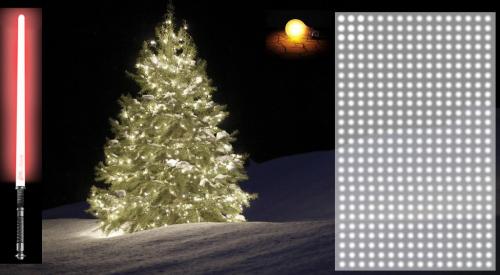
Salida
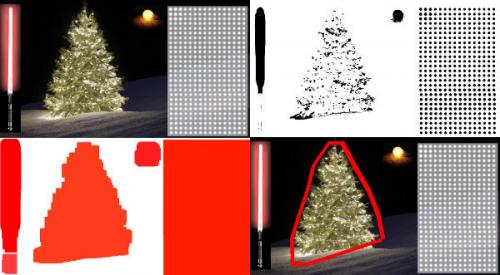
Warning: date(): Invalid date.timezone value 'Europe/Kyiv', we selected the timezone 'UTC' for now. in /var/www/agent_stack/data/www/ajaxhispano.com/template/agent.layouts/content.php on line 61
2014-01-02 10:03:18
Aquí está mi solución simple y tonta. Se basa en la suposición de que el árbol será la cosa más brillante y grande en la imagen.
//g++ -Wall -pedantic -ansi -O2 -pipe -s -o christmas_tree christmas_tree.cpp `pkg-config --cflags --libs opencv`
#include <opencv2/imgproc/imgproc.hpp>
#include <opencv2/highgui/highgui.hpp>
#include <iostream>
using namespace cv;
using namespace std;
int main(int argc,char *argv[])
{
Mat original,tmp,tmp1;
vector <vector<Point> > contours;
Moments m;
Rect boundrect;
Point2f center;
double radius, max_area=0,tmp_area=0;
unsigned int j, k;
int i;
for(i = 1; i < argc; ++i)
{
original = imread(argv[i]);
if(original.empty())
{
cerr << "Error"<<endl;
return -1;
}
GaussianBlur(original, tmp, Size(3, 3), 0, 0, BORDER_DEFAULT);
erode(tmp, tmp, Mat(), Point(-1, -1), 10);
cvtColor(tmp, tmp, CV_BGR2HSV);
inRange(tmp, Scalar(0, 0, 0), Scalar(180, 255, 200), tmp);
dilate(original, tmp1, Mat(), Point(-1, -1), 15);
cvtColor(tmp1, tmp1, CV_BGR2HLS);
inRange(tmp1, Scalar(0, 185, 0), Scalar(180, 255, 255), tmp1);
dilate(tmp1, tmp1, Mat(), Point(-1, -1), 10);
bitwise_and(tmp, tmp1, tmp1);
findContours(tmp1, contours, CV_RETR_EXTERNAL, CV_CHAIN_APPROX_SIMPLE);
max_area = 0;
j = 0;
for(k = 0; k < contours.size(); k++)
{
tmp_area = contourArea(contours[k]);
if(tmp_area > max_area)
{
max_area = tmp_area;
j = k;
}
}
tmp1 = Mat::zeros(original.size(),CV_8U);
approxPolyDP(contours[j], contours[j], 30, true);
drawContours(tmp1, contours, j, Scalar(255,255,255), CV_FILLED);
m = moments(contours[j]);
boundrect = boundingRect(contours[j]);
center = Point2f(m.m10/m.m00, m.m01/m.m00);
radius = (center.y - (boundrect.tl().y))/4.0*3.0;
Rect heightrect(center.x-original.cols/5, boundrect.tl().y, original.cols/5*2, boundrect.size().height);
tmp = Mat::zeros(original.size(), CV_8U);
rectangle(tmp, heightrect, Scalar(255, 255, 255), -1);
circle(tmp, center, radius, Scalar(255, 255, 255), -1);
bitwise_and(tmp, tmp1, tmp1);
findContours(tmp1, contours, CV_RETR_EXTERNAL, CV_CHAIN_APPROX_SIMPLE);
max_area = 0;
j = 0;
for(k = 0; k < contours.size(); k++)
{
tmp_area = contourArea(contours[k]);
if(tmp_area > max_area)
{
max_area = tmp_area;
j = k;
}
}
approxPolyDP(contours[j], contours[j], 30, true);
convexHull(contours[j], contours[j]);
drawContours(original, contours, j, Scalar(0, 0, 255), 3);
namedWindow(argv[i], CV_WINDOW_NORMAL|CV_WINDOW_KEEPRATIO|CV_GUI_EXPANDED);
imshow(argv[i], original);
waitKey(0);
destroyWindow(argv[i]);
}
return 0;
}
El primer paso es detectar los píxeles más brillantes de la imagen, pero tenemos que hacer una distinción entre el árbol en sí y la nieve que refleja su luz. Aquí tratamos de excluir la nieve aplicando un filtro muy simple en los códigos de color:
GaussianBlur(original, tmp, Size(3, 3), 0, 0, BORDER_DEFAULT);
erode(tmp, tmp, Mat(), Point(-1, -1), 10);
cvtColor(tmp, tmp, CV_BGR2HSV);
inRange(tmp, Scalar(0, 0, 0), Scalar(180, 255, 200), tmp);
Entonces encontramos cada píxel "brillante":
dilate(original, tmp1, Mat(), Point(-1, -1), 15);
cvtColor(tmp1, tmp1, CV_BGR2HLS);
inRange(tmp1, Scalar(0, 185, 0), Scalar(180, 255, 255), tmp1);
dilate(tmp1, tmp1, Mat(), Point(-1, -1), 10);
Finalmente nos unimos a la dos resultados:
bitwise_and(tmp, tmp1, tmp1);
Ahora buscamos el objeto brillante más grande:
findContours(tmp1, contours, CV_RETR_EXTERNAL, CV_CHAIN_APPROX_SIMPLE);
max_area = 0;
j = 0;
for(k = 0; k < contours.size(); k++)
{
tmp_area = contourArea(contours[k]);
if(tmp_area > max_area)
{
max_area = tmp_area;
j = k;
}
}
tmp1 = Mat::zeros(original.size(),CV_8U);
approxPolyDP(contours[j], contours[j], 30, true);
drawContours(tmp1, contours, j, Scalar(255,255,255), CV_FILLED);
Ya casi hemos terminado, pero todavía hay algunas imperfecciones debido a la nieve. Para cortarlos construiremos una máscara usando un círculo y un rectángulo para aproximarse a la forma de un árbol para eliminar piezas no deseadas:
m = moments(contours[j]);
boundrect = boundingRect(contours[j]);
center = Point2f(m.m10/m.m00, m.m01/m.m00);
radius = (center.y - (boundrect.tl().y))/4.0*3.0;
Rect heightrect(center.x-original.cols/5, boundrect.tl().y, original.cols/5*2, boundrect.size().height);
tmp = Mat::zeros(original.size(), CV_8U);
rectangle(tmp, heightrect, Scalar(255, 255, 255), -1);
circle(tmp, center, radius, Scalar(255, 255, 255), -1);
bitwise_and(tmp, tmp1, tmp1);
El último paso es encontrar el contorno de nuestro árbol y dibujarlo en la imagen original.
findContours(tmp1, contours, CV_RETR_EXTERNAL, CV_CHAIN_APPROX_SIMPLE);
max_area = 0;
j = 0;
for(k = 0; k < contours.size(); k++)
{
tmp_area = contourArea(contours[k]);
if(tmp_area > max_area)
{
max_area = tmp_area;
j = k;
}
}
approxPolyDP(contours[j], contours[j], 30, true);
convexHull(contours[j], contours[j]);
drawContours(original, contours, j, Scalar(0, 0, 255), 3);
Lo siento, pero por el momento tengo una mala conexión, por lo que no es posible para subir fotos. Intentaré hacerlo más tarde.
Feliz Navidad.
EDITAR:
Aquí algunas fotos de la salida final:
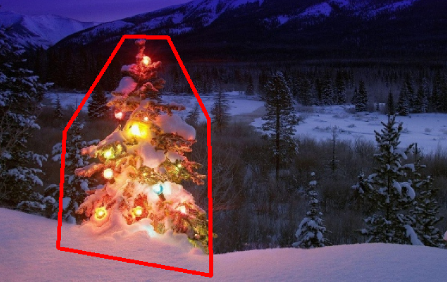
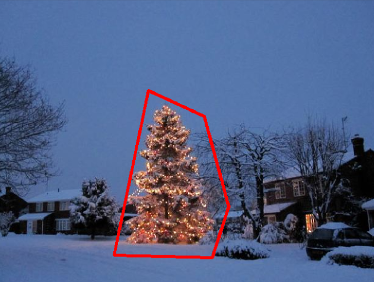

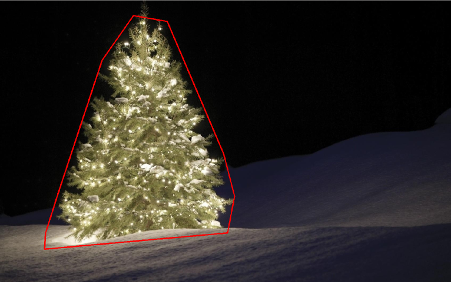
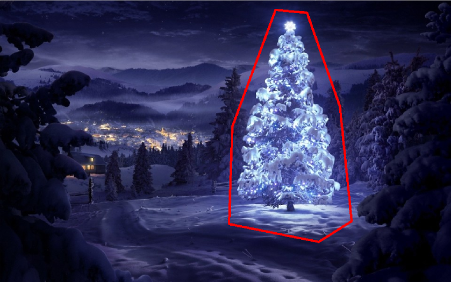

Warning: date(): Invalid date.timezone value 'Europe/Kyiv', we selected the timezone 'UTC' for now. in /var/www/agent_stack/data/www/ajaxhispano.com/template/agent.layouts/content.php on line 61
2013-12-26 20:10:43
Escribí el código en Matlab R2007a. Utilicé k-means para extraer aproximadamente el árbol de Navidad. Me mostrará mi resultado intermedio solo con una imagen,y los resultados finales con los seis.
Primero, mapeé el espacio RGB en el espacio de laboratorio, lo que podría mejorar el contraste de rojo en su canal b:
colorTransform = makecform('srgb2lab');
I = applycform(I, colorTransform);
L = double(I(:,:,1));
a = double(I(:,:,2));
b = double(I(:,:,3));
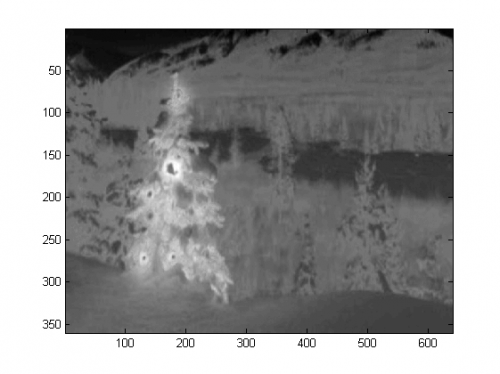
Además de la función en el espacio de color, también utilicé la función de textura que es relevante con el barrio en lugar de cada píxel en sí. Aquí linealmente combinado la intensidad de la 3 canales originales (R, G, B). La razón por la que formateé de esta manera es porque la navidad todos los árboles de la foto tienen luces rojas, y a veces verdes / a veces azules iluminación también.
R=double(Irgb(:,:,1));
G=double(Irgb(:,:,2));
B=double(Irgb(:,:,3));
I0 = (3*R + max(G,B)-min(G,B))/2;

Apliqué un patrón binario local de 3X3 en I0, usé el píxel central como umbral, y
se obtiene el contraste calculando la diferencia entre el valor medio de intensidad de píxel
por encima del umbral y el valor medio por debajo se.
I0_copy = zeros(size(I0));
for i = 2 : size(I0,1) - 1
for j = 2 : size(I0,2) - 1
tmp = I0(i-1:i+1,j-1:j+1) >= I0(i,j);
I0_copy(i,j) = mean(mean(tmp.*I0(i-1:i+1,j-1:j+1))) - ...
mean(mean(~tmp.*I0(i-1:i+1,j-1:j+1))); % Contrast
end
end
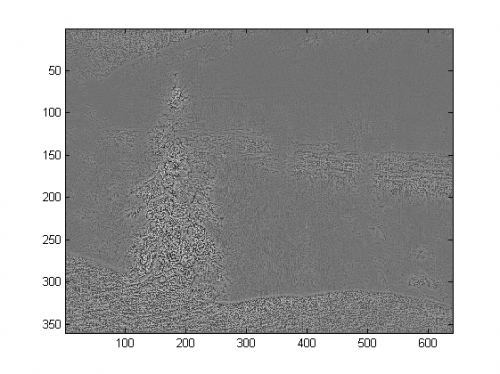
Dado que tengo 4 características en total, elegiría K=5 en mi método de clustering. El código para k-means se muestran a continuación (es del curso de aprendizaje automático del Dr. Andrew Ng. Tomé el curso anterior, y yo mismo escribí el código en su asignación de programación).
[centroids, idx] = runkMeans(X, initial_centroids, max_iters);
mask=reshape(idx,img_size(1),img_size(2));
%%%%%%%%%%%%%%%%%%%%%%%%%%%%%%%%%%%%%%%%%%%%%%%%%%%%
function [centroids, idx] = runkMeans(X, initial_centroids, ...
max_iters, plot_progress)
[m n] = size(X);
K = size(initial_centroids, 1);
centroids = initial_centroids;
previous_centroids = centroids;
idx = zeros(m, 1);
for i=1:max_iters
% For each example in X, assign it to the closest centroid
idx = findClosestCentroids(X, centroids);
% Given the memberships, compute new centroids
centroids = computeCentroids(X, idx, K);
end
%%%%%%%%%%%%%%%%%%%%%%%%%%%%%%%%%%%%%%%%%%%%%%%%%%%%%%%
function idx = findClosestCentroids(X, centroids)
K = size(centroids, 1);
idx = zeros(size(X,1), 1);
for xi = 1:size(X,1)
x = X(xi, :);
% Find closest centroid for x.
best = Inf;
for mui = 1:K
mu = centroids(mui, :);
d = dot(x - mu, x - mu);
if d < best
best = d;
idx(xi) = mui;
end
end
end
%%%%%%%%%%%%%%%%%%%%%%%%%%%%%%%%%%%
function centroids = computeCentroids(X, idx, K)
[m n] = size(X);
centroids = zeros(K, n);
for mui = 1:K
centroids(mui, :) = sum(X(idx == mui, :)) / sum(idx == mui);
end
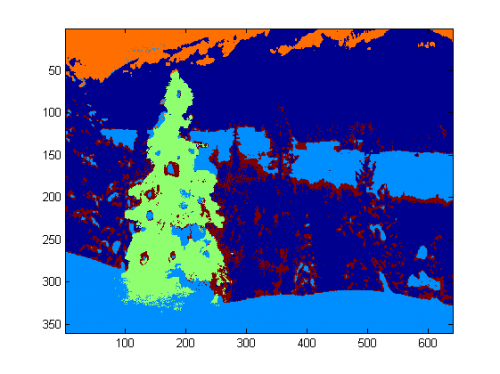
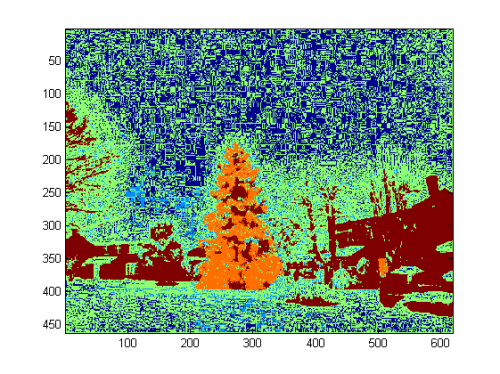

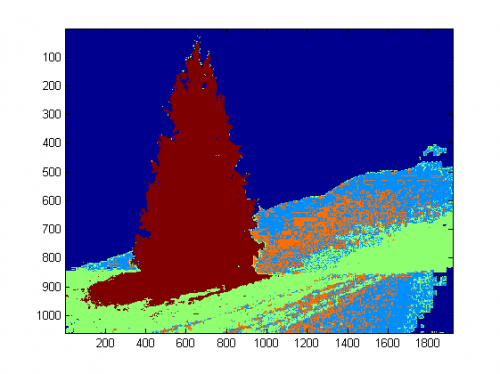
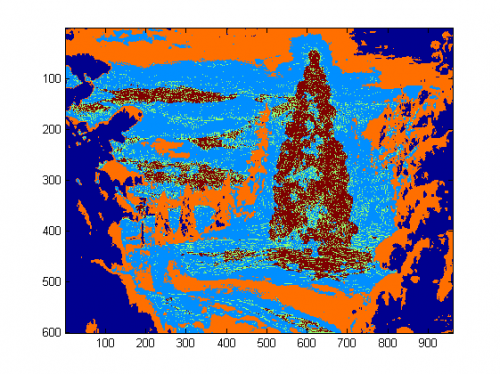

Dado que el programa se ejecuta muy lento en mi computadora, acabo de ejecutar 3 iteraciones. Normalmente la parada el criterio es (i) tiempo de iteración al menos 10, o (ii) ningún cambio en los centroides más. A mi prueba, el aumento de la iteración puede diferenciar el fondo (cielo y árbol, cielo y edificio,...) más exactamente, pero no mostró cambios drásticos en el árbol de navidad extracción. También tenga en cuenta que k-means no es inmune a la inicialización centroide aleatoria, por lo que se recomienda ejecutar el programa varias veces para hacer una comparación.
Después de la media k, se eligió la región etiquetada con la intensidad máxima de I0. Y
límite se utilizó el rastreo para extraer los límites. Para mí, el último árbol de Navidad es el más difícil de extraer ya que el contraste en esa imagen no es lo suficientemente alto como lo son en los primeros cinco. Otro problema en mi método es que usé la función bwboundaries en Matlab para rastrear el límite, pero a veces los límites internos también se incluyen como se puede observar en los resultados 3rd, 5th, 6th. El lado oscuro dentro de los árboles de Navidad no solo no se agrupan con el lado iluminado, sino que también conducen a tantos pequeños límites internos trazando (imfill no mejora mucho). En todo mi algoritmo todavía tiene mucho espacio de mejora.


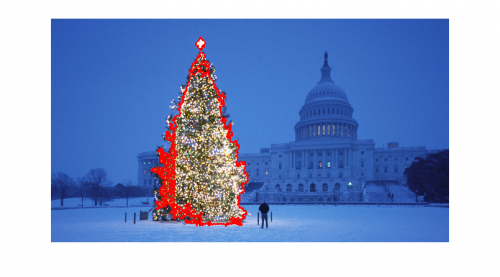
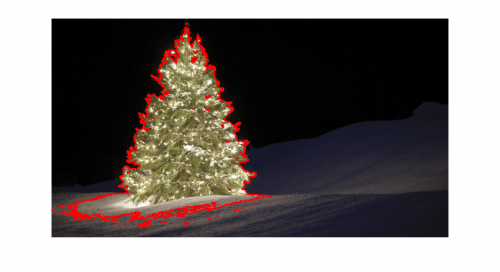
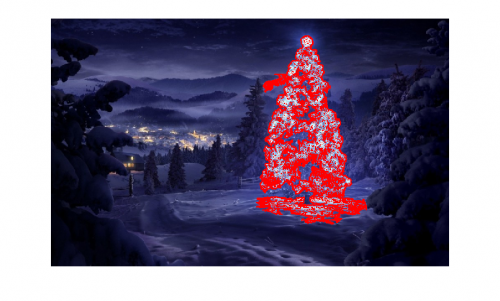
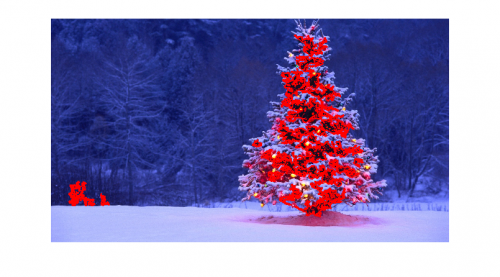
Algunas publicaciones indican que el desplazamiento de la media puede ser más robusto que las medias k, y muchos los algoritmos basados en graph-cut también son muy competitivos en límites complicados segmentación. Escribí un algoritmo de cambio de media yo mismo, parece que mejor extraer las regiones sin suficiente luz. Pero mean-shift está un poco sobre-segmentado, y alguna estrategia de es necesario fusionar. Se ejecutó incluso mucho más lento que k-significa en mi ordenador, me temo que tengo para dejarlo. Espero ansiosamente ver que otros presenten excelentes resultados aquí con esos algoritmos modernos mencionados anteriormente.
Sin embargo, siempre creo que la selección de características es el componente clave en la segmentación de imágenes. Con una selección de características adecuada que puede maximizar el margen entre el objeto y antecedentes, muchos los algoritmos de segmentación definitivamente funcionarán. Diferentes algoritmos pueden mejorar el resultado de 1 a 10, pero la selección de características puede mejorarlo de 0 a 1.
¡Feliz Navidad !
Warning: date(): Invalid date.timezone value 'Europe/Kyiv', we selected the timezone 'UTC' for now. in /var/www/agent_stack/data/www/ajaxhispano.com/template/agent.layouts/content.php on line 61
2013-12-27 04:21:33
Este es mi último post usando los enfoques tradicionales de procesamiento de imágenes...
Aquí de alguna manera combino mis otras dos propuestas, logrando resultados aún mejores. De hecho, no puedo ver cómo estos resultados podrían ser mejores (especialmente cuando miras las imágenes enmascaradas que produce el método).
En el corazón del enfoque está la combinación de tres supuestos clave :
- Las imágenes deben tener altas fluctuaciones en el árbol regiones
- Las imágenes deben tener mayor intensidad en las regiones arbóreas
- Las regiones de fondo deben tener baja intensidad y ser en su mayoría azules
Con estas suposiciones en mente, el método funciona de la siguiente manera:
- Convertir las imágenes a HSV
- Filtra el canal V con un filtro LoG
- Aplique umbrales duros en la imagen filtrada de registro para obtener la máscara de 'actividad' A
- Aplicar umbral duro al canal V para obtener la máscara de intensidad B
- Aplicar umbral de canal H para capturar regiones ish azules de baja intensidad en la máscara de fondo C
- Combinar máscaras usando Y para obtener la máscara final
- Dilate la máscara para agrandar regiones y conectar píxeles dispersos
- Elimine las regiones pequeñas y obtenga la máscara final que eventualmente representará solo el árbol
Aquí está el código en MATLAB (de nuevo, el script carga todas las imágenes jpg en la carpeta actual y, de nuevo, esto está lejos de ser un código optimizado):
% clear everything
clear;
pack;
close all;
close all hidden;
drawnow;
clc;
% initialization
ims=dir('./*.jpg');
imgs={};
images={};
blur_images={};
log_image={};
dilated_image={};
int_image={};
back_image={};
bin_image={};
measurements={};
box={};
num=length(ims);
thres_div = 3;
for i=1:num,
% load original image
imgs{end+1}=imread(ims(i).name);
% convert to HSV colorspace
images{end+1}=rgb2hsv(imgs{i});
% apply laplacian filtering and heuristic hard thresholding
val_thres = (max(max(images{i}(:,:,3)))/thres_div);
log_image{end+1} = imfilter( images{i}(:,:,3),fspecial('log')) > val_thres;
% get the most bright regions of the image
int_thres = 0.26*max(max( images{i}(:,:,3)));
int_image{end+1} = images{i}(:,:,3) > int_thres;
% get the most probable background regions of the image
back_image{end+1} = images{i}(:,:,1)>(150/360) & images{i}(:,:,1)<(320/360) & images{i}(:,:,3)<0.5;
% compute the final binary image by combining
% high 'activity' with high intensity
bin_image{end+1} = logical( log_image{i}) & logical( int_image{i}) & ~logical( back_image{i});
% apply morphological dilation to connect distonnected components
strel_size = round(0.01*max(size(imgs{i}))); % structuring element for morphological dilation
dilated_image{end+1} = imdilate( bin_image{i}, strel('disk',strel_size));
% do some measurements to eliminate small objects
measurements{i} = regionprops( logical( dilated_image{i}),'Area','BoundingBox');
% iterative enlargement of the structuring element for better connectivity
while length(measurements{i})>14 && strel_size<(min(size(imgs{i}(:,:,1)))/2),
strel_size = round( 1.5 * strel_size);
dilated_image{i} = imdilate( bin_image{i}, strel('disk',strel_size));
measurements{i} = regionprops( logical( dilated_image{i}),'Area','BoundingBox');
end
for m=1:length(measurements{i})
if measurements{i}(m).Area < 0.05*numel( dilated_image{i})
dilated_image{i}( round(measurements{i}(m).BoundingBox(2):measurements{i}(m).BoundingBox(4)+measurements{i}(m).BoundingBox(2)),...
round(measurements{i}(m).BoundingBox(1):measurements{i}(m).BoundingBox(3)+measurements{i}(m).BoundingBox(1))) = 0;
end
end
% make sure the dilated image is the same size with the original
dilated_image{i} = dilated_image{i}(1:size(imgs{i},1),1:size(imgs{i},2));
% compute the bounding box
[y,x] = find( dilated_image{i});
if isempty( y)
box{end+1}=[];
else
box{end+1} = [ min(x) min(y) max(x)-min(x)+1 max(y)-min(y)+1];
end
end
%%% additional code to display things
for i=1:num,
figure;
subplot(121);
colormap gray;
imshow( imgs{i});
if ~isempty(box{i})
hold on;
rr = rectangle( 'position', box{i});
set( rr, 'EdgeColor', 'r');
hold off;
end
subplot(122);
imshow( imgs{i}.*uint8(repmat(dilated_image{i},[1 1 3])));
end
Resultados
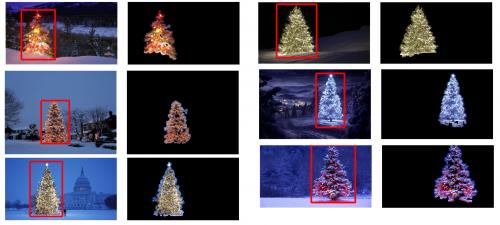
Resultados de Alta resolución todavía disponible aquí!
Incluso más experimentos con imágenes adicionales se pueden encontrar aquí.
Warning: date(): Invalid date.timezone value 'Europe/Kyiv', we selected the timezone 'UTC' for now. in /var/www/agent_stack/data/www/ajaxhispano.com/template/agent.layouts/content.php on line 61
2013-12-30 19:04:34
Mis pasos de solución:
-
Get R channel (from RGB) - todas las operaciones que hacemos en este canal:
-
Crear Región de Interés (ROI)
-
Canal umbral R con valor mínimo 149 (imagen superior derecha)
Dilatar la región del resultado (imagen central izquierda)
-
-
Detectar eges en el roi calculado. El árbol tiene muchos bordes (imagen central derecha)
Dilatar resultado
-
Erosionar con más grande radio (imagen inferior izquierda)
-
Seleccione el objeto más grande (por área) - es la región de resultado
-
ConvexHull ( árbol es polígono convexo) (imagen inferior derecha)
-
Cuadro delimitador (imagen inferior derecha - cuadro grren)
Paso a paso:

El primer resultado-más simple pero no en software de código abierto- " Adaptive Vision Studio + Adaptive Vision Library": Esto no es de código abierto, pero muy rápido para prototipo:
Algoritmo completo para detectar el árbol de Navidad (11 bloques):
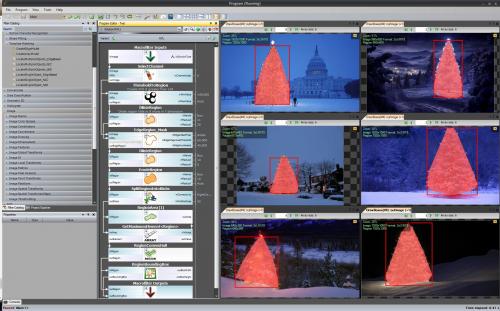
Siguiente paso. Queremos una solución de código abierto. Cambiar filtros AVL a filtros OpenCV: Aquí hice pequeños cambios, por ejemplo, Detección de bordes use el filtro cvCanny, para respetar el roi multiplicé la imagen de región con la imagen de bordes, para seleccionar el elemento más grande usé findContours + contourArea, pero la idea es la igual.
Https://www.youtube.com/watch?v=sfjB3MigLH0&index=1&list=UUpSRrkMHNHiLDXgylwhWNQQ

Ahora no puedo mostrar imágenes con pasos intermedios porque solo puedo poner 2 enlaces.
Ok ahora usamos filtros de código abierto, pero no es todavía todo de código abierto. Último paso-portar al código c++. Usé OpenCV en la versión 2.4.4
El resultado del código final de c++ es:
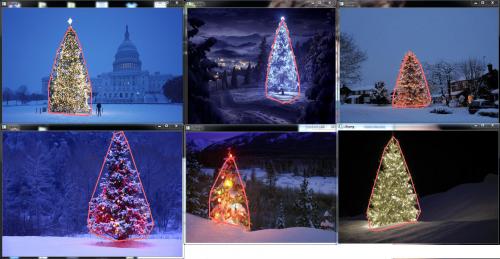
El código C++ también es bastante corto:
#include "opencv2/highgui/highgui.hpp"
#include "opencv2/opencv.hpp"
#include <algorithm>
using namespace cv;
int main()
{
string images[6] = {"..\\1.png","..\\2.png","..\\3.png","..\\4.png","..\\5.png","..\\6.png"};
for(int i = 0; i < 6; ++i)
{
Mat img, thresholded, tdilated, tmp, tmp1;
vector<Mat> channels(3);
img = imread(images[i]);
split(img, channels);
threshold( channels[2], thresholded, 149, 255, THRESH_BINARY); //prepare ROI - threshold
dilate( thresholded, tdilated, getStructuringElement( MORPH_RECT, Size(22,22) ) ); //prepare ROI - dilate
Canny( channels[2], tmp, 75, 125, 3, true ); //Canny edge detection
multiply( tmp, tdilated, tmp1 ); // set ROI
dilate( tmp1, tmp, getStructuringElement( MORPH_RECT, Size(20,16) ) ); // dilate
erode( tmp, tmp1, getStructuringElement( MORPH_RECT, Size(36,36) ) ); // erode
vector<vector<Point> > contours, contours1(1);
vector<Point> convex;
vector<Vec4i> hierarchy;
findContours( tmp1, contours, hierarchy, CV_RETR_TREE, CV_CHAIN_APPROX_SIMPLE, Point(0, 0) );
//get element of maximum area
//int bestID = std::max_element( contours.begin(), contours.end(),
// []( const vector<Point>& A, const vector<Point>& B ) { return contourArea(A) < contourArea(B); } ) - contours.begin();
int bestID = 0;
int bestArea = contourArea( contours[0] );
for( int i = 1; i < contours.size(); ++i )
{
int area = contourArea( contours[i] );
if( area > bestArea )
{
bestArea = area;
bestID = i;
}
}
convexHull( contours[bestID], contours1[0] );
drawContours( img, contours1, 0, Scalar( 100, 100, 255 ), img.rows / 100, 8, hierarchy, 0, Point() );
imshow("image", img );
waitKey(0);
}
return 0;
}
Warning: date(): Invalid date.timezone value 'Europe/Kyiv', we selected the timezone 'UTC' for now. in /var/www/agent_stack/data/www/ajaxhispano.com/template/agent.layouts/content.php on line 61
2014-10-22 16:37:32
...otra solución anticuada-puramente basada en el procesamiento HSV:
- Convertir imágenes al espacio de color HSV
- Crear máscaras de acuerdo con la heurística en el VHS (ver más abajo)
- Aplicar dilatación morfológica a la máscara para conectar áreas desconectadas
- Deseche áreas pequeñas y bloques horizontales (recuerde que los árboles son bloques verticales)
- Calcular el cuadro delimitador
Una palabra sobre la heurística en el VHS procesamiento:
- todo con Tonos (H) entre 210-320 grados se descarta como azul-magenta que se supone que está en el fondo o en áreas no relevantes
- todo lo que tenga Valores (V) inferiores al 40% también se descarta por ser demasiado oscuro para ser relevante
Por supuesto, uno puede experimentar con muchas otras posibilidades para afinar este enfoque...
Aquí está el código de MATLAB para hacer el truco( advertencia: el código está lejos de ser optimizado!!! Utilicé técnicas no recomendadas para la programación de MATLAB solo para poder rastrear cualquier cosa en el proceso, esto se puede optimizar en gran medida):
% clear everything
clear;
pack;
close all;
close all hidden;
drawnow;
clc;
% initialization
ims=dir('./*.jpg');
num=length(ims);
imgs={};
hsvs={};
masks={};
dilated_images={};
measurements={};
boxs={};
for i=1:num,
% load original image
imgs{end+1} = imread(ims(i).name);
flt_x_size = round(size(imgs{i},2)*0.005);
flt_y_size = round(size(imgs{i},1)*0.005);
flt = fspecial( 'average', max( flt_y_size, flt_x_size));
imgs{i} = imfilter( imgs{i}, flt, 'same');
% convert to HSV colorspace
hsvs{end+1} = rgb2hsv(imgs{i});
% apply a hard thresholding and binary operation to construct the mask
masks{end+1} = medfilt2( ~(hsvs{i}(:,:,1)>(210/360) & hsvs{i}(:,:,1)<(320/360))&hsvs{i}(:,:,3)>0.4);
% apply morphological dilation to connect distonnected components
strel_size = round(0.03*max(size(imgs{i}))); % structuring element for morphological dilation
dilated_images{end+1} = imdilate( masks{i}, strel('disk',strel_size));
% do some measurements to eliminate small objects
measurements{i} = regionprops( dilated_images{i},'Perimeter','Area','BoundingBox');
for m=1:length(measurements{i})
if (measurements{i}(m).Area < 0.02*numel( dilated_images{i})) || (measurements{i}(m).BoundingBox(3)>1.2*measurements{i}(m).BoundingBox(4))
dilated_images{i}( round(measurements{i}(m).BoundingBox(2):measurements{i}(m).BoundingBox(4)+measurements{i}(m).BoundingBox(2)),...
round(measurements{i}(m).BoundingBox(1):measurements{i}(m).BoundingBox(3)+measurements{i}(m).BoundingBox(1))) = 0;
end
end
dilated_images{i} = dilated_images{i}(1:size(imgs{i},1),1:size(imgs{i},2));
% compute the bounding box
[y,x] = find( dilated_images{i});
if isempty( y)
boxs{end+1}=[];
else
boxs{end+1} = [ min(x) min(y) max(x)-min(x)+1 max(y)-min(y)+1];
end
end
%%% additional code to display things
for i=1:num,
figure;
subplot(121);
colormap gray;
imshow( imgs{i});
if ~isempty(boxs{i})
hold on;
rr = rectangle( 'position', boxs{i});
set( rr, 'EdgeColor', 'r');
hold off;
end
subplot(122);
imshow( imgs{i}.*uint8(repmat(dilated_images{i},[1 1 3])));
end
Resultados:
En los resultados muestro la imagen enmascarada y el cuadro delimitador.
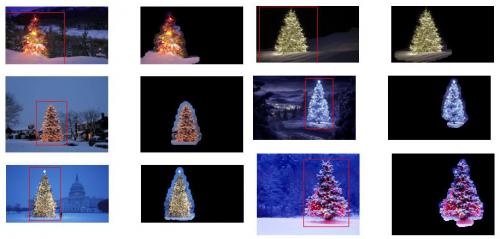
Warning: date(): Invalid date.timezone value 'Europe/Kyiv', we selected the timezone 'UTC' for now. in /var/www/agent_stack/data/www/ajaxhispano.com/template/agent.layouts/content.php on line 61
2013-12-27 18:40:32
Algún enfoque anticuado de procesamiento de imágenes...
La idea se basa en la suposición de que las imágenes representan árboles iluminados en fondos típicamente más oscuros y suaves (o primeros planos en algunos casos). El área de árboles iluminados es más "energética" y tiene mayor intensidad.
El proceso es el siguiente:
- Convertir a graylevel
- Aplicar el filtrado de registros para obtener las áreas más "activas"
- Aplique un umbral intencionado para obtener el mayor brillo zonas
- Combina las 2 anteriores para obtener una máscara preliminar
- Aplicar una dilatación morfológica para ampliar áreas y conectar componentes vecinos
- Eliminar las áreas candidatas pequeñas de acuerdo con su tamaño de área
Lo que obtienes es una máscara binaria y un cuadro delimitador para cada imagen.
Aquí están los resultados usando esta técnica ingenua:
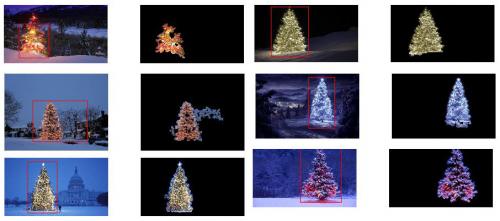
El código en MATLAB sigue: El código se ejecuta en una carpeta con imágenes JPG. Carga todo imágenes y devuelve los resultados detectados.
% clear everything
clear;
pack;
close all;
close all hidden;
drawnow;
clc;
% initialization
ims=dir('./*.jpg');
imgs={};
images={};
blur_images={};
log_image={};
dilated_image={};
int_image={};
bin_image={};
measurements={};
box={};
num=length(ims);
thres_div = 3;
for i=1:num,
% load original image
imgs{end+1}=imread(ims(i).name);
% convert to grayscale
images{end+1}=rgb2gray(imgs{i});
% apply laplacian filtering and heuristic hard thresholding
val_thres = (max(max(images{i}))/thres_div);
log_image{end+1} = imfilter( images{i},fspecial('log')) > val_thres;
% get the most bright regions of the image
int_thres = 0.26*max(max( images{i}));
int_image{end+1} = images{i} > int_thres;
% compute the final binary image by combining
% high 'activity' with high intensity
bin_image{end+1} = log_image{i} .* int_image{i};
% apply morphological dilation to connect distonnected components
strel_size = round(0.01*max(size(imgs{i}))); % structuring element for morphological dilation
dilated_image{end+1} = imdilate( bin_image{i}, strel('disk',strel_size));
% do some measurements to eliminate small objects
measurements{i} = regionprops( logical( dilated_image{i}),'Area','BoundingBox');
for m=1:length(measurements{i})
if measurements{i}(m).Area < 0.05*numel( dilated_image{i})
dilated_image{i}( round(measurements{i}(m).BoundingBox(2):measurements{i}(m).BoundingBox(4)+measurements{i}(m).BoundingBox(2)),...
round(measurements{i}(m).BoundingBox(1):measurements{i}(m).BoundingBox(3)+measurements{i}(m).BoundingBox(1))) = 0;
end
end
% make sure the dilated image is the same size with the original
dilated_image{i} = dilated_image{i}(1:size(imgs{i},1),1:size(imgs{i},2));
% compute the bounding box
[y,x] = find( dilated_image{i});
if isempty( y)
box{end+1}=[];
else
box{end+1} = [ min(x) min(y) max(x)-min(x)+1 max(y)-min(y)+1];
end
end
%%% additional code to display things
for i=1:num,
figure;
subplot(121);
colormap gray;
imshow( imgs{i});
if ~isempty(box{i})
hold on;
rr = rectangle( 'position', box{i});
set( rr, 'EdgeColor', 'r');
hold off;
end
subplot(122);
imshow( imgs{i}.*uint8(repmat(dilated_image{i},[1 1 3])));
end
Warning: date(): Invalid date.timezone value 'Europe/Kyiv', we selected the timezone 'UTC' for now. in /var/www/agent_stack/data/www/ajaxhispano.com/template/agent.layouts/content.php on line 61
2013-12-30 13:56:50
Usando un enfoque bastante diferente de lo que he visto, creé un script php que detecta árboles de Navidad por sus luces. El resultado es siempre un triángulo simétrico, y si es necesario valores numéricos como el ángulo ("gordura") del árbol.
La mayor amenaza para este algoritmo obviamente son las luces al lado (en grandes números) o delante del árbol (el mayor problema hasta una mayor optimización). Editar (agregado): Lo que no puede hacer: Averiguar si hay un árbol de Navidad o no, encuentre varios árboles de Navidad en una imagen, detecte correctamente un árbol de Navidad en el medio de Las Vegas, detecte árboles de Navidad que están muy doblados, boca abajo o talados... ;)
Las diferentes etapas son:
- Calcular el brillo añadido (R+G+B) para cada píxel
- Suma este valor de los 8 píxeles vecinos encima de cada píxel
- Clasificar todos los píxeles por este valor (más brillante primero) - Lo sé, no muy sutil...
- Elija N de estos, a partir de la parte superior, omitiendo los que están demasiado cerca
- Calcule la mediana de estos N superiores (nos da el centro aproximado del árbol)
- Comience desde la posición mediana hacia arriba en un haz de búsqueda que se ensancha para la luz más alta de las más brillantes seleccionadas (la gente tiende a poner al menos una luz en la parte superior)
- A partir de ahí, imagine líneas que van 60 grados a la izquierda y a la derecha hacia abajo (los árboles de Navidad no deberían ser tan gordos)
- Disminución esos 60 grados hasta que el 20% de las luces más brillantes están fuera de este triángulo
- Encuentra la luz en la parte inferior del triángulo, dándole el borde horizontal inferior del árbol
- Hecho
Explicación de las marcas:
- Gran cruz roja en el centro del árbol: Mediana de las N luces más brillantes
- Línea de puntos desde allí hacia arriba:" haz de búsqueda " para la parte superior del árbol
- Cruz roja más pequeña: copa del árbol
- Realmente pequeñas cruces rojas: Todas las N luces más brillantes
- triángulo Rojo: D'uh!
Código fuente:
<?php
ini_set('memory_limit', '1024M');
header("Content-type: image/png");
$chosenImage = 6;
switch($chosenImage){
case 1:
$inputImage = imagecreatefromjpeg("nmzwj.jpg");
break;
case 2:
$inputImage = imagecreatefromjpeg("2y4o5.jpg");
break;
case 3:
$inputImage = imagecreatefromjpeg("YowlH.jpg");
break;
case 4:
$inputImage = imagecreatefromjpeg("2K9Ef.jpg");
break;
case 5:
$inputImage = imagecreatefromjpeg("aVZhC.jpg");
break;
case 6:
$inputImage = imagecreatefromjpeg("FWhSP.jpg");
break;
case 7:
$inputImage = imagecreatefromjpeg("roemerberg.jpg");
break;
default:
exit();
}
// Process the loaded image
$topNspots = processImage($inputImage);
imagejpeg($inputImage);
imagedestroy($inputImage);
// Here be functions
function processImage($image) {
$orange = imagecolorallocate($image, 220, 210, 60);
$black = imagecolorallocate($image, 0, 0, 0);
$red = imagecolorallocate($image, 255, 0, 0);
$maxX = imagesx($image)-1;
$maxY = imagesy($image)-1;
// Parameters
$spread = 1; // Number of pixels to each direction that will be added up
$topPositions = 80; // Number of (brightest) lights taken into account
$minLightDistance = round(min(array($maxX, $maxY)) / 30); // Minimum number of pixels between the brigtests lights
$searchYperX = 5; // spread of the "search beam" from the median point to the top
$renderStage = 3; // 1 to 3; exits the process early
// STAGE 1
// Calculate the brightness of each pixel (R+G+B)
$maxBrightness = 0;
$stage1array = array();
for($row = 0; $row <= $maxY; $row++) {
$stage1array[$row] = array();
for($col = 0; $col <= $maxX; $col++) {
$rgb = imagecolorat($image, $col, $row);
$brightness = getBrightnessFromRgb($rgb);
$stage1array[$row][$col] = $brightness;
if($renderStage == 1){
$brightnessToGrey = round($brightness / 765 * 256);
$greyRgb = imagecolorallocate($image, $brightnessToGrey, $brightnessToGrey, $brightnessToGrey);
imagesetpixel($image, $col, $row, $greyRgb);
}
if($brightness > $maxBrightness) {
$maxBrightness = $brightness;
if($renderStage == 1){
imagesetpixel($image, $col, $row, $red);
}
}
}
}
if($renderStage == 1) {
return;
}
// STAGE 2
// Add up brightness of neighbouring pixels
$stage2array = array();
$maxStage2 = 0;
for($row = 0; $row <= $maxY; $row++) {
$stage2array[$row] = array();
for($col = 0; $col <= $maxX; $col++) {
if(!isset($stage2array[$row][$col])) $stage2array[$row][$col] = 0;
// Look around the current pixel, add brightness
for($y = $row-$spread; $y <= $row+$spread; $y++) {
for($x = $col-$spread; $x <= $col+$spread; $x++) {
// Don't read values from outside the image
if($x >= 0 && $x <= $maxX && $y >= 0 && $y <= $maxY){
$stage2array[$row][$col] += $stage1array[$y][$x]+10;
}
}
}
$stage2value = $stage2array[$row][$col];
if($stage2value > $maxStage2) {
$maxStage2 = $stage2value;
}
}
}
if($renderStage >= 2){
// Paint the accumulated light, dimmed by the maximum value from stage 2
for($row = 0; $row <= $maxY; $row++) {
for($col = 0; $col <= $maxX; $col++) {
$brightness = round($stage2array[$row][$col] / $maxStage2 * 255);
$greyRgb = imagecolorallocate($image, $brightness, $brightness, $brightness);
imagesetpixel($image, $col, $row, $greyRgb);
}
}
}
if($renderStage == 2) {
return;
}
// STAGE 3
// Create a ranking of bright spots (like "Top 20")
$topN = array();
for($row = 0; $row <= $maxY; $row++) {
for($col = 0; $col <= $maxX; $col++) {
$stage2Brightness = $stage2array[$row][$col];
$topN[$col.":".$row] = $stage2Brightness;
}
}
arsort($topN);
$topNused = array();
$topPositionCountdown = $topPositions;
if($renderStage == 3){
foreach ($topN as $key => $val) {
if($topPositionCountdown <= 0){
break;
}
$position = explode(":", $key);
foreach($topNused as $usedPosition => $usedValue) {
$usedPosition = explode(":", $usedPosition);
$distance = abs($usedPosition[0] - $position[0]) + abs($usedPosition[1] - $position[1]);
if($distance < $minLightDistance) {
continue 2;
}
}
$topNused[$key] = $val;
paintCrosshair($image, $position[0], $position[1], $red, 2);
$topPositionCountdown--;
}
}
// STAGE 4
// Median of all Top N lights
$topNxValues = array();
$topNyValues = array();
foreach ($topNused as $key => $val) {
$position = explode(":", $key);
array_push($topNxValues, $position[0]);
array_push($topNyValues, $position[1]);
}
$medianXvalue = round(calculate_median($topNxValues));
$medianYvalue = round(calculate_median($topNyValues));
paintCrosshair($image, $medianXvalue, $medianYvalue, $red, 15);
// STAGE 5
// Find treetop
$filename = 'debug.log';
$handle = fopen($filename, "w");
fwrite($handle, "\n\n STAGE 5");
$treetopX = $medianXvalue;
$treetopY = $medianYvalue;
$searchXmin = $medianXvalue;
$searchXmax = $medianXvalue;
$width = 0;
for($y = $medianYvalue; $y >= 0; $y--) {
fwrite($handle, "\nAt y = ".$y);
if(($y % $searchYperX) == 0) { // Modulo
$width++;
$searchXmin = $medianXvalue - $width;
$searchXmax = $medianXvalue + $width;
imagesetpixel($image, $searchXmin, $y, $red);
imagesetpixel($image, $searchXmax, $y, $red);
}
foreach ($topNused as $key => $val) {
$position = explode(":", $key); // "x:y"
if($position[1] != $y){
continue;
}
if($position[0] >= $searchXmin && $position[0] <= $searchXmax){
$treetopX = $position[0];
$treetopY = $y;
}
}
}
paintCrosshair($image, $treetopX, $treetopY, $red, 5);
// STAGE 6
// Find tree sides
fwrite($handle, "\n\n STAGE 6");
$treesideAngle = 60; // The extremely "fat" end of a christmas tree
$treeBottomY = $treetopY;
$topPositionsExcluded = 0;
$xymultiplier = 0;
while(($topPositionsExcluded < ($topPositions / 5)) && $treesideAngle >= 1){
fwrite($handle, "\n\nWe're at angle ".$treesideAngle);
$xymultiplier = sin(deg2rad($treesideAngle));
fwrite($handle, "\nMultiplier: ".$xymultiplier);
$topPositionsExcluded = 0;
foreach ($topNused as $key => $val) {
$position = explode(":", $key);
fwrite($handle, "\nAt position ".$key);
if($position[1] > $treeBottomY) {
$treeBottomY = $position[1];
}
// Lights above the tree are outside of it, but don't matter
if($position[1] < $treetopY){
$topPositionsExcluded++;
fwrite($handle, "\nTOO HIGH");
continue;
}
// Top light will generate division by zero
if($treetopY-$position[1] == 0) {
fwrite($handle, "\nDIVISION BY ZERO");
continue;
}
// Lights left end right of it are also not inside
fwrite($handle, "\nLight position factor: ".(abs($treetopX-$position[0]) / abs($treetopY-$position[1])));
if((abs($treetopX-$position[0]) / abs($treetopY-$position[1])) > $xymultiplier){
$topPositionsExcluded++;
fwrite($handle, "\n --- Outside tree ---");
}
}
$treesideAngle--;
}
fclose($handle);
// Paint tree's outline
$treeHeight = abs($treetopY-$treeBottomY);
$treeBottomLeft = 0;
$treeBottomRight = 0;
$previousState = false; // line has not started; assumes the tree does not "leave"^^
for($x = 0; $x <= $maxX; $x++){
if(abs($treetopX-$x) != 0 && abs($treetopX-$x) / $treeHeight > $xymultiplier){
if($previousState == true){
$treeBottomRight = $x;
$previousState = false;
}
continue;
}
imagesetpixel($image, $x, $treeBottomY, $red);
if($previousState == false){
$treeBottomLeft = $x;
$previousState = true;
}
}
imageline($image, $treeBottomLeft, $treeBottomY, $treetopX, $treetopY, $red);
imageline($image, $treeBottomRight, $treeBottomY, $treetopX, $treetopY, $red);
// Print out some parameters
$string = "Min dist: ".$minLightDistance." | Tree angle: ".$treesideAngle." deg | Tree bottom: ".$treeBottomY;
$px = (imagesx($image) - 6.5 * strlen($string)) / 2;
imagestring($image, 2, $px, 5, $string, $orange);
return $topN;
}
/**
* Returns values from 0 to 765
*/
function getBrightnessFromRgb($rgb) {
$r = ($rgb >> 16) & 0xFF;
$g = ($rgb >> 8) & 0xFF;
$b = $rgb & 0xFF;
return $r+$r+$b;
}
function paintCrosshair($image, $posX, $posY, $color, $size=5) {
for($x = $posX-$size; $x <= $posX+$size; $x++) {
if($x>=0 && $x < imagesx($image)){
imagesetpixel($image, $x, $posY, $color);
}
}
for($y = $posY-$size; $y <= $posY+$size; $y++) {
if($y>=0 && $y < imagesy($image)){
imagesetpixel($image, $posX, $y, $color);
}
}
}
// From http://www.mdj.us/web-development/php-programming/calculating-the-median-average-values-of-an-array-with-php/
function calculate_median($arr) {
sort($arr);
$count = count($arr); //total numbers in array
$middleval = floor(($count-1)/2); // find the middle value, or the lowest middle value
if($count % 2) { // odd number, middle is the median
$median = $arr[$middleval];
} else { // even number, calculate avg of 2 medians
$low = $arr[$middleval];
$high = $arr[$middleval+1];
$median = (($low+$high)/2);
}
return $median;
}
?>
Imágenes:
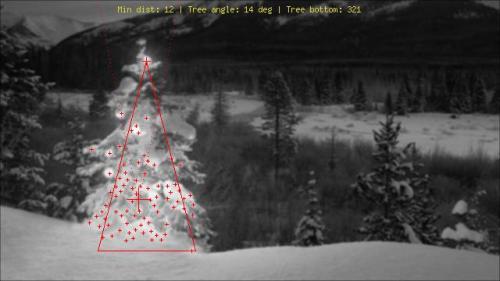
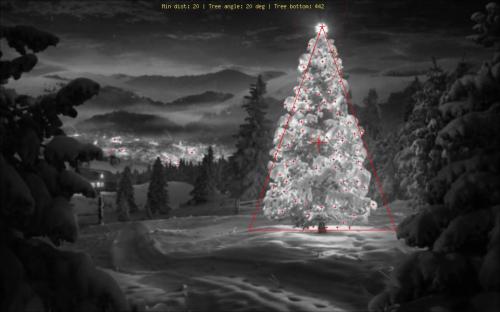




Bonus: Un Weihnachtsbaum alemán, de Wikipedia
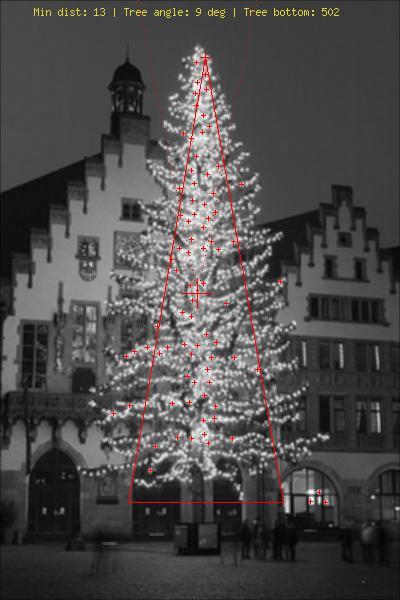 http://commons.wikimedia.org/wiki/File:Weihnachtsbaum_R%C3%B6merberg.jpg
http://commons.wikimedia.org/wiki/File:Weihnachtsbaum_R%C3%B6merberg.jpg
Warning: date(): Invalid date.timezone value 'Europe/Kyiv', we selected the timezone 'UTC' for now. in /var/www/agent_stack/data/www/ajaxhispano.com/template/agent.layouts/content.php on line 61
2014-01-02 23:55:14
Utilicé python con opencv.
Mi algoritmo es así:
- Primero toma el canal rojo de la imagen
- Aplicar un umbral (valor mínimo 200) al canal rojo
- Luego aplicar Gradiente morfológico y luego hacer un 'Cierre' (dilatación seguida de Erosión)
- Luego encuentra los contornos en el plano y elige el contorno más largo.
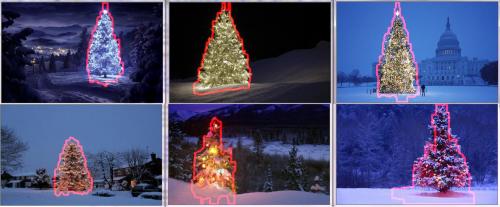
El código:
import numpy as np
import cv2
import copy
def findTree(image,num):
im = cv2.imread(image)
im = cv2.resize(im, (400,250))
gray = cv2.cvtColor(im, cv2.COLOR_RGB2GRAY)
imf = copy.deepcopy(im)
b,g,r = cv2.split(im)
minR = 200
_,thresh = cv2.threshold(r,minR,255,0)
kernel = np.ones((25,5))
dst = cv2.morphologyEx(thresh, cv2.MORPH_GRADIENT, kernel)
dst = cv2.morphologyEx(dst, cv2.MORPH_CLOSE, kernel)
contours = cv2.findContours(dst,cv2.RETR_TREE,cv2.CHAIN_APPROX_SIMPLE)[0]
cv2.drawContours(im, contours,-1, (0,255,0), 1)
maxI = 0
for i in range(len(contours)):
if len(contours[maxI]) < len(contours[i]):
maxI = i
img = copy.deepcopy(r)
cv2.polylines(img,[contours[maxI]],True,(255,255,255),3)
imf[:,:,2] = img
cv2.imshow(str(num), imf)
def main():
findTree('tree.jpg',1)
findTree('tree2.jpg',2)
findTree('tree3.jpg',3)
findTree('tree4.jpg',4)
findTree('tree5.jpg',5)
findTree('tree6.jpg',6)
cv2.waitKey(0)
cv2.destroyAllWindows()
if __name__ == "__main__":
main()
Si cambio el núcleo de (25,5) a (10,5)
Tengo mejores resultados en todos los árboles excepto en la parte inferior izquierda,

Mi algoritmo asume que el árbol tiene luces en él, y en el árbol inferior izquierdo, la parte superior tiene menos luz que los otros.
Warning: date(): Invalid date.timezone value 'Europe/Kyiv', we selected the timezone 'UTC' for now. in /var/www/agent_stack/data/www/ajaxhispano.com/template/agent.layouts/content.php on line 61
2014-01-30 21:46:58